2. 河北地质大学资源学院, 石家庄 050031;
3. 内蒙古矿业科技研究院有限公司, 呼和浩特 010050
2. School of Resource, Hebei GEO University, Shijiazhuang 050031, China;
3. Mining Science and Technology Institute Limited Company, Hohhot, 010050, China
介于西伯利亚板块、华北板块以及塔里木板块之间的中亚造山带是全球显生宙大陆地壳生长最为显著的增生造山带之一(图 1a,Şengör et al., 1993;Jahn et al., 2000;Khain et al., 2002;Xiao et al., 2003;Jahn, 2004;Li, 2006;Kröner et al., 2007;Xu et al., 2013;Eizenhöfer et al., 2014)。其东段为中国内蒙古及东北地区,传统上将其称为兴蒙造山带,记录了华北板块与其北部各陆块的碰撞拼合过程,是研究中亚造山带构造演化的重要区域。目前,对于兴蒙造山带的形成过程仍未有定论,争论焦点集中在古亚洲洋最终闭合的位置与时限等问题,主要有两种观点:(1)早古生代古亚洲洋发生双向俯冲,形成“双冲造山带”构造格局,在中泥盆世之前碰撞拼合形成兴蒙造山带(Zhang and Tang, 1989;Xu et al., 2013;Zhao et al., 2013),而在晚古生代进入造山后伸展作用阶段,发育主动裂谷带和被动裂谷带等(Jahn et al., 2000;徐备等,2014);(2)古亚洲洋双向俯冲发生整个古生代,导致众多岛弧与微陆块逐步拼贴在一起,最终在晚二叠世末或早三叠世初形成兴蒙造山带(Xiao et al., 2003;Chen et al., 2009;Eizenhöfer et al., 2014;Li et al., 2014)。
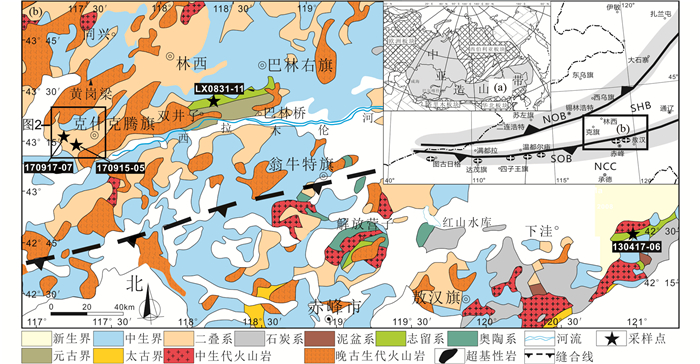
|
图 1 中亚造山带东段构造单元划分与西拉木伦地区地质简图(据徐备等,2014;程胜东等,2014修改) (a)中亚造山带东段的区域位置与构造单元划分方案,NCC-华北板块;SHB-松辽-浑善达克地块;SOB-南造山带;NOB-北造山带;(b)西拉木伦地区地质简图 Fig. 1 Tectonic subdivision of the eastern Central Asia Orogenic Belt and geological sketch map in Xar Moron River area (modified after Xu et al., 2014; Cheng et al., 2014) |
解决上述争议的有效途径之一是对关键地区晚古生代末的地质体、特别是沉积建造进行详细研究,以便推断当时的沉积古地理格局和沉积环境是否与古亚洲洋闭合有关。因此,西拉木伦河以北的晚古生代地层成为众多研究者选择的工作热点区,并已发表了一批重要成果(韩国卿等,2011;韩杰等,2011;Eizenhöfer et al., 2014;Han et al., 2015;李红英等,2016;王丹丹等,2016;赵英利等,2016;朱俊宾和和政军,2017)。尽管上述研究者们根据晚古生代地层的物源及时代等方面的研究成果提出古亚洲洋闭合于晚二叠世末或晚石炭世等不同观点,但这些研究均未把沉积相与沉积环境的识别作为研究重点,也没有分析晚二叠世沉积盆地的构造背景。本次研究从实测地层剖面入手,通过详细的沉积相与沉积环境研究,并结合碎屑锆石年代学分析,探讨西拉木伦河以北地区晚古生代沉积古地理格局和构造演化。
1 区域地质背景研究区位于内蒙古自治区克什克腾旗以北的义成元到柳条子沟之间(图 2),属于兴蒙造山带东段。兴蒙造山带可以分为北造山带、南造山带以及夹在中间的松辽-浑善达克地块(图 1a,Jian et al., 2010;Xu et al., 2013)。北造山带(NOB)沿艾力格庙-苏尼特左旗-锡林浩特-西乌旗一线延伸,沿线分布早古生代岩浆岩、蛇绿混杂岩和磨拉石盆地(Xu et al., 2013;徐备等,2014)。南造山带(SOB)从西向东沿图古日格-达茂旗-温都尔庙-正镶白旗-敖汉旗-吉中-延吉一线分布,沿线分布早古生代岛弧岩浆岩,从西向东包括图古日格地区包尔汉图群火山岩及侵入岩(453~425Ma,Xu et al., 2013)、达茂旗北部侵入岩(452~446Ma,张维和简平,2008)、温都尔庙地区白乃庙群火山岩及侵入岩(474~437Ma,Zhang et al., 2013)、正镶白旗二长花岗岩(457±11Ma,秦亚等,2013)、内蒙古翁牛特旗小营子二长花岗岩(419.3±9.2Ma,陈井胜等,2017)及吉中地区张家屯英云闪长岩(443±5Ma,裴福萍等,2014)。松辽-浑善达克地块东部被松辽盆地、西部被浑善达克沙地所覆盖,呈东宽西窄的三角形,由于覆盖严重,基底出露较少,仅见于地块边缘地区(徐备等,2014)。
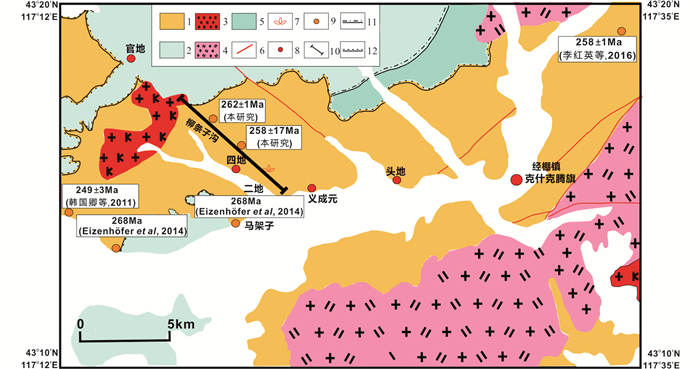
|
图 2 研究区地质简图(据内蒙古地质矿产勘查开发局,1998①;据韩国卿等,2011修改) 1-P2-3哲斯组;2-J3白音高老组;3-J3黑云母钾长花岗岩;4-J3黑云母二长花岗岩;5-J3满克头鄂博组;6-断层;7-植物化石;8-城镇;9-年龄数据;10-实测剖面;11-平行不整合界线;12-角度不整合界线 Fig. 2 Sketch geological map of studied area (modified after Han et al., 2011) 1-P2-3 Zhesi Fm.; 2-J3 Baiying Gaolao Fm.; 3-J3 biotite moyite; 4-J3 biotite adamellite; 5-J3 Manketou Obo Fm.; 6-fault; 7-plant fossil; 8-village; 9-age data; 10-stratigraphic section; 11-parallel unconformity boundary; 12-angular unconformity boundary |
① 内蒙古地质矿产勘查开发局. 1998. 1: 25万林西县幅区域地质调查报告
本研究区位于松辽-浑善达克地块西部(图 1b),该地区普遍出露二叠纪地层。根据1: 25万林西县幅区域地质矿产报告,区内二叠系地层包括寿山沟组、大石寨组、哲斯组以及林西组。其中,寿山沟组主要岩性为灰黑色粉砂质泥岩、黑色板岩夹灰色砂砾岩及砂岩。大石寨组主要在黄岗梁-八楞山地区出露,岩性主要是一套浅海喷发的中、酸性熔岩及凝灰岩,局部夹正常碎屑岩(内蒙古地质矿产勘查开发局,1998)。哲斯组下段为灰黑色变质粉砂岩与板岩互层,夹生物碎屑灰岩,含中二叠世的腕足类、珊瑚和牙型类化石(杨兵等,2017);中段为灰绿色韵律性变质细砂岩与板岩互层;上段为灰色块状炭质粉砂岩、板岩,夹灰岩透镜体,海相化石以腕足类为主,菊石等次之,并有大量植物化石(邵济安等,2014)。林西组在林西东北部分布广泛,上段为粉砂质板岩、变质细粒长石岩屑砂岩夹变质粗砂岩、灰黑色粉砂质板岩与变质细砂岩,含植物和淡水双壳类化石;中段以黑色板岩、粗砂质板岩夹变质砂岩透镜体为主,化石类型与上段基本相同;下段为变质中细粒砂岩、粉砂岩夹板岩、变质砾岩夹变质砂岩。
2 哲斯组地层沉积学研究 2.1 克旗西部实测剖面位置与概况本研究对克什克腾旗西部二叠纪哲斯组地层进行了实测工作,剖面起点位于义成元附近,终点柳条子沟北部,全长约4km(图 2)。剖面共分为24层,下部未见底,顶部被侏罗纪花岗岩侵入。地层产状以正常倾向NW为主,未见明显的地层重复与倒转,总厚度为3007m(图 3)。
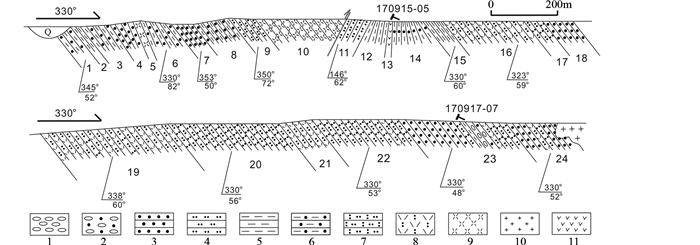
|
图 3 克什克腾旗北部中晚二叠统哲斯组实测地层剖面 1-泥砾岩;2-含砾砂岩;3-砂岩;4-粉砂岩;5-泥岩;6-砂泥互层;7-凝灰质砂岩;8-凝灰岩;9-流纹岩;10-花岗岩;11-安山岩 Fig. 3 Cross section of the mid-late Permian Zhesi Formation in the north of Hexigten 1-gompholite; 2-conglomerate-bearing sandstone; 3-sandstone; 4-siltstone; 5-mudstone; 6-sand-mud interbed series; 7-tuffaceous sandstone; 8-tuff; 9-rhyolite; 10-granite; 11-andesite |
根据岩性组合,剖面可划分为上、中、下三段,具体剖面描述如下:
24.黄色砂岩、灰绿色凝灰质砂岩、灰黑色凝灰岩构成韵律层,147m
23.滑塌堆积层,由薄层黄色砂岩、黑色泥砾岩、含砾砂岩组成,发育斜层理,326m
22.灰绿色凝灰质砂岩,发育水平层理与斜层理,上部夹一层厚约3m的灰色凝灰岩,257m
21.黑色凝灰岩,下部夹一层厚约3m的黄色凝灰质砂岩,99m
20.灰绿色凝灰质砂岩,含粒径约3cm的火山岩砾石,332m
19.灰黑色凝灰岩夹薄层凝灰质砂岩,凝灰岩单层厚约15m,凝灰质砂岩单层厚约2m,414m
18.灰绿色砂岩,发育水平层理,73m
17.黑色、黄绿色凝灰质砂岩,发育水平层理及斜层理,59m
16.黄绿色、灰黑色、白色凝灰岩,含直径1~3cm的泥砾,230m
15.黄绿色、黑色泥岩,破碎严重,52m
14.黄绿色泥岩与绿色砂岩互层,泥岩厚5~10m,砂岩厚2~4m,87m
13.浅黄色安山岩,可见黑色角闪石斑晶,3m
12.黄色泥岩,内部结构均匀,上部过渡为砂泥互层,55m
11.含砾黄色、绿色粉砂岩,发育水平层理,67m
10.浅黄色流纹岩,斑状结构,块状构造,268m
9.黄绿色粉砂岩,含火山岩岩屑,65m
8.黄绿色砂岩与黑色、黄色泥岩互层,砂岩含黑色泥砾,95m
7.厚层灰绿色砂岩,发育水平层理,61m
6.土黄色、灰绿色砂岩与黄绿色泥岩互层,砂岩厚0.8~1.5m,泥岩厚约0.5m,77m
5.浅黄色流纹岩,斑状结构,块状构造,18m
4.土黄色砂岩,发育水平层理,局部夹薄层黄褐色泥岩,62m
3.灰绿色砂岩与薄层泥岩或粉砂岩互层,含植物化石碎片,互层厚度约0.3m,81m
2.灰黑色泥岩,块状构造,含黄色泥砾,20m
1.土黄色砂岩与薄层泥岩互层,砂岩含黑色泥砾,厚0.5~1m,泥岩约0.3m,59m
------------ -未见底-------------
2.2 沉积环境与沉积相分析哲斯组剖面下段为1~9层(图 4),在第1、2和8层的巨厚层砂岩中含有扁平状黑色泥砾(图 4g),其长轴约1~2cm(图 4b),具有拉长撕裂等同沉积变形构造(图 4c),反映快速沉降条件下分选不佳的突发性滑塌沉积事件,推测应处于三角洲前缘位置。第3~7层主要为厚层灰绿色砂岩夹薄层泥岩或粉砂岩构成的旋回(图 4a),含植物化石碎片(图 4d),发育水平层理(图 4f),说明处于水动力条件稳定、分选较好的沉积环境,应属于前三角洲。第9层为黄绿色粉砂岩,含火山岩岩屑,直径约2cm(图 4h)。总之,哲斯组下段总体以大规模滑塌堆积和正常沉积互层为特点,反映了三角洲前缘和前三角洲环境的交替,并开始接受火山物质。

|
图 4 哲斯组地层下段岩性柱状图与沉积现象野外照片 (a)砂岩与泥岩互层韵律;(b)含砾砂岩;(c)黑色泥岩;(d)植物化石残片;(e)砂泥互层;(f)绿色砂岩;(g)含砾砂岩;(h)绿色粉砂岩中的火山岩岩屑.柱状图中颜色表示地层实际色彩 Fig. 4 Petrological column and photos of sedimentary phenomenon from lower section of the Zhesi Formation (a) sandstone-mudstone interbedding; (b) pebbly sandstone; (c) black mudstone; (d) plant fossil discovered in pebbled sandstone; (e) sandstone-mudstone interbedding; (f) green sandstone; (g) black gravel in sandstone; (h) green volcanic lithic fragment in tuffaceous sandstone. The color in the histogram indicates the actual color of the Formation |
哲斯组剖面中段为10~21层(图 5)。总体显示碎屑岩与火山岩的交替出现。火山岩包括浅黄色流纹岩(图 5a)和黑色凝灰岩(图 5e),镜下可见长石晶体与火山岩岩屑(图 5f)。流纹岩厚度可达240m以上。碎屑岩可见绿色砂岩-粉砂岩-泥岩粒度逐渐变细的正粒序(图 5b),凝灰质砂岩发育水平层理(图 5c, h)和斜层理(图 5d),并含火山岩岩屑(图 5g),表明水动力条件较强、分选条件较好,继承了下段前三角洲的沉积环境。另一方面,地层中发育火山岩和含火山岩岩屑的厚层凝灰岩、凝灰质砂岩,表明盆地附近火山喷发作用十分强烈,提供了充足的物源。

|
图 5 哲斯组地层中段岩性柱状图与沉积现象野外照片 (a)流纹岩;(b)砂岩-泥岩正粒序;(c)砂岩中的水平层理;(d)凝灰质砂岩中的斜层理;(e)黑色凝灰岩;(f)凝灰岩镜下照片(+);(g)含有绿色火山岩岩屑的凝灰质砂岩;(h)砂岩中的水平层理 Fig. 5 Petrological column and photos of sedimentary phenomenon of middle section from the Zhesi Formation (a) rhyolite; (b) fining upward sequence comprised of sandstone-mudstone; (c) horizontal bedding in sandstone; (d) oblique stratification in tuffaceous sandstone; (e) black tuff; (f) microscopic photo of tuff (+); (g) green volcanic lithic fragment in tuffaceous sandstone; (h) horizontal bedding in sandstone |
哲斯组剖面上段由正常碎屑岩夹滑塌堆积层组成(图 6)。下部第22层为巨厚层灰黑色凝灰质砂岩(图 6a),发育水平层理和斜层理,上部第24层为黄色砂岩、灰绿色凝灰质砂岩、灰绿色凝灰岩构成的韵律层,水平层理发育(图 6d),处于水动力条件较强、分选条件较好的前三角洲沉积环境。中部的第23层为滑塌堆积层,其底部发育薄层黑色泥岩,向上过渡为巨厚层含大量单成分泥砾的中砾岩,泥砾呈压扁或撕裂状、定向排列(图 6b);填隙物为粗砂岩,分选差(图 6c),应为大规模滑塌堆积产物。因此本段总体仍属前三角洲与三角洲前缘交替环境下的沉积。
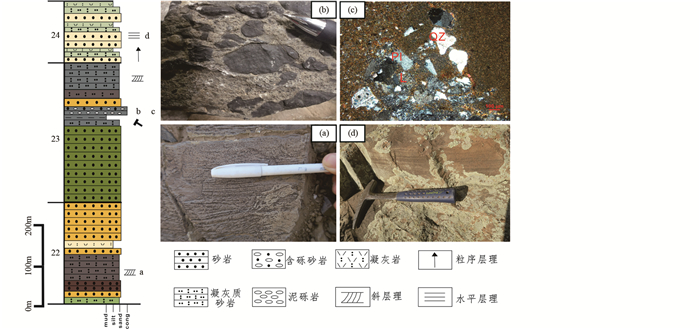
|
图 6 哲斯组地层上段岩性柱状图与沉积现象野外照片 (a)凝灰质砂岩;(b)泥砾岩;(c)砾岩的填隙物为粗砂岩(+);(d)砂岩中的水平层理.QZ-单晶石英; Pl-斜长石; L-泥岩岩屑 Fig. 6 Petrological column and photos of sedimentary phenomenon of upper section from the Zhesi Formation (a) tuffaceous sandstone; (b) gompholite; (c) microscopic photo of gompholite (+); (d) horizontal bedding in sandstone. Qz-quartz; Pl-plagioclase; L-lithic fragment |
综上所述,哲斯组沉积环境为三角洲前缘相与前三角洲相的多次交替,沉积过程受到火山活动的影响。
3 锆石年代学研究 3.1 样品介绍本次研究选取了凝灰质砂岩和安山岩做年代测定。样品170917-07为凝灰质砂岩(图 7a),采于剖面第23层(GPS坐标43°17′05″N、117°18′16″E)。镜下观察主要成分为火山灰(40%)、岩屑(30%)、长石(20%)和石英(10%)。样品成熟度不高,分选较差,次棱角状,岩屑成分为泥岩和变质岩等,火山灰主要由安山质岩屑及长石晶屑构成(图 7b)。样品170915-05为安山岩(图 7c),采于剖面第13层(GPS坐标43°15′28″N、117°20′32″E),块状构造,斑状结构。镜下观察其矿物组成主要为斜长石和角闪石,交织结构。斜长石呈自形细板条状,发育聚片双晶;角闪石为淡黄色,半自形长柱状,大都蚀变为绿泥石(图 7d)。
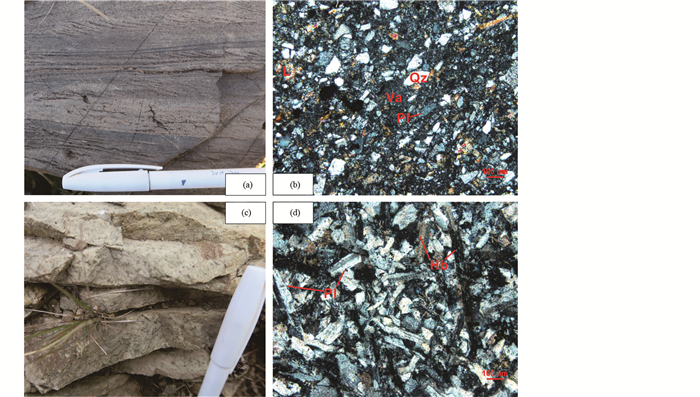
|
图 7 锆石年代学样品野外照片(a、c)及正交偏光镜下特征照片(b、d) (a、b)样品170917-07;(c、d)样品170915-05.Qz-单晶石英;Pl-斜长石;Hb-角闪石;Va-火山灰;L-岩屑 Fig. 7 Field photos (a, c) and microscopic photos under CPL (b, d) of zircon chronological samples (a, b) Sample 170917-07;(c, d) Sample170915-05. Qz-quartz; Pl-plagioclase; Hb-hornblende; Va-volcanic ash; L-lithic fragment |
锆石年代学样品首先经过常规方法碎样,再经过过筛、浮选、磁选、介电分离等过程完成重矿物挑选,最后挑选出锆石单矿物。挑选出的锆石单矿物经环氧树脂浇铸、打磨、抛光等工序完成锆石样品靶的制备,过程与制作SHRIMP定年的样品靶基本相同(宋彪等,2002)。利用光学显微镜对样品靶进行透射光与反射光图像的拍摄;利用扫描电子显微镜对样品靶拍摄阴极发光图像,最后依据透射光、反射光和阴极发光图像综合选取测试点。
锆石年代学测试在北京大学造山带与地壳演化教育部重点实验室进行,测试方法为LA-ICP-MS原位微区U-Pb同位素定年。测试仪器为电感耦合等离子质谱仪(型号为Agilent 7500 Ce),剥蚀所用激光器为ArF准分子激光器(型号为COMPExPro102),其激光束能量密度为10J/cm2,频率为5Hz,直径为24μm或32μm。测试仪器系统中使用He作为剥蚀物质载气,Ar为辅助气。U-Pb同位素年龄的计算与校正使用标准锆石Plesovice作为外标,其ID-TIMS所测定年龄为337.13±0.37Ma(Sláma et al., 2008),使用标准锆石91500作为监控盲样(Wiedenbeck et al., 1995);元素含量的校正使用标准玻璃样品NIST610作为外标,标准玻璃样品NIST612、NIST614作为内标。测试过程中首先对待测样品进行15次脉冲激光的预剥蚀,关闭激光并采集20s背景值信号,随即进行300次脉冲激光剥蚀并同时采集样品信号。标准样品的测试密度为每5个样品间测试1个监控盲样91500,每10个样品之间加测1个年龄外标Plesovice、1个元素外标NIST610,每20个样品间测试1个元素内标NIST612与NIST614。锆石年代学样品同位素比值与元素含量数据的处理使用GLITTER 4.4.2软件进行,普通Pb含量的校正使用204Pb校正程序(Andersen and Griffin, 2004)进行,U-Pb谐和年龄图、碎屑锆石年龄谱的绘制使用Isoplot 3.75(Ludwig,2003)进行,分析数据及锆石U-Pb谐和图给出误差为1σ,95%的置信度。
3.3 测试结果凝灰质砂岩样品170917-07得到年龄数据75个,其中7个数据不协和度大于10%,将其剔除后得到68个有效年龄数据,测试结果见表 1。结合锆石CL图像(图 8)及U-Pb谐和图(图 9a)特征,可将数据分为四组:247~309Ma(N=25)、401~475Ma(N=26)、581~1424Ma(N=10)、1731~2446Ma (N=7)。第一组峰值年龄为263Ma,除去偏离谐和线的2颗锆石外,5颗锆石得到262±1Ma的谐和年龄(图 9a)。该组锆石晶体形态好,自形长柱状,长宽比约2: 1,Th/U值为0.3~1.56,具有较宽的振荡环带,表现出岩浆锆石特征。第二组峰值年龄为440Ma,锆石多呈自形柱状,长宽比约2: 1~3: 1,晶体形态总体较好,岩浆振荡环带清晰,Th/U值在0.07~1.48之间,除去12号点Th/U值为0.07,具有变质锆石特征外,多为岩浆成因。第三组锆石自形-半自形,多呈粒状,环带较为清晰,Th/U值介于0.14~1.59之间,显示岩浆成因。第四组锆石晶体形态较差,环带较为发育,Th/U值在0.19~0.98之间,具岩浆锆石特征(Rubatto and Hermann, 2003)。
|
|
表 1 克什克腾旗哲斯组样品锆石U-Pb测年结果 Table 1 Results of LA-ICP-MS zircon U-Pb age dating for the Zhesi Formation in Hexigten Banner |

|
图 8 锆石年代学样品阴极发光图像 (a)样品170917-07 U-Pb谐和图与碎屑锆石年龄谱;(b)样品170915-05 U-Pb谐和图 Fig. 8 CL images of zircons from the chronological study samples (a) detrital zircon age spectrum and U-Pb concordia diagram of Sample 170917-07;(b) U-Pb concordia diagram of zircon from Sample 170915-05 |
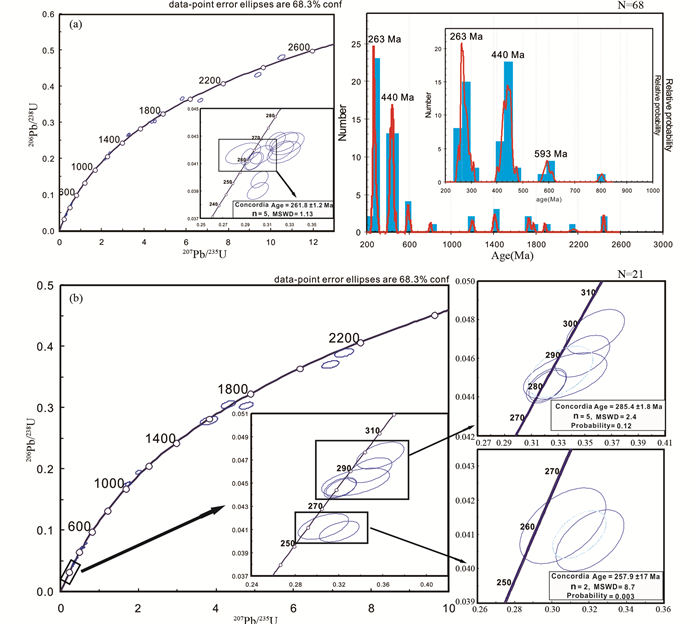
|
图 9 克什克腾旗西部哲斯组样品锆石年代学测试结果 Fig. 9 Zircon chronological dating result of samples from the Zhesi Formation in Hexigten Banner |
火山岩样品170915-05得到年龄数据30个,其中9个数据不协和度大于10%,将其剔除后得到21个有效年龄数据,测试结果见表 1。根据年龄分布范围并结合CL图像特征(图 8、图 9b),测试结果可分为四组:258~261Ma(A组,2颗)、281~298Ma(B组,5颗)、315~485Ma(C组,6颗)、1033~2180Ma(D组,8颗)。A组锆石呈粒状,晶体形态较差,2颗锆石Th/U值均为0.94,其谐和年龄为258±17Ma。B组5颗锆石得到的谐和年龄为285±2Ma,晶体形态较好,岩浆振荡环带清晰,Th/U值介于0.59~1.15之间,属于岩浆锆石。C组锆石半自形粒状,环带细密,Th/U值在0.14~0.72之间,表现岩浆锆石特征。D组锆石自形-半自形,柱状或粒状,Th/U值介于0.03~1.45之间,除去15号点Th/U值为0.03、具有变质锆石特征外,多为岩浆成因。
4 讨论 4.1 地层形成时代凝灰质砂岩样品(170917-07)最年轻的一组锆石的谐和年龄为262±1Ma,安山岩样品最年轻的一组锆石给出258±17Ma的谐和年龄,另外Eizenhöfer et al.(2014)在剖面西部的马架子附近得到碎屑锆石的峰值年龄为268Ma,李红英等(2016)在克旗北部5km处得到最年轻的碎屑锆石年龄为258±1Ma,根据这些数据,研究区哲斯组的形成时代可以确定为中-晚二叠世。
4.2 古流向恢复在哲斯组剖面中段和上段的凝灰质砂岩中发育斜层理(图 5d、图 6a),可以用于确定充填盆地中沉积物的搬运方向并进而推断物源区位置。本文在野外剖面第23层测得15组斜层理产状,因斜层理的倾角均大于10°(图 7a),故用吴氏网室内校正与制作玫瑰花图的方法进行古流向分析(孙连浦,2005)。
通过对15组斜层理前积层倾向的恢复可知(图 10),古水流的主要方向为北西和北东,说明物源主要来自南部,即研究区以南广阔的华北克拉通与华北北缘早古生代陆缘弧是主要的物源区;4组南东方向的古水流说明部分物源也可能来自于研究区北部的松辽-浑善达克地块。这种双向古水流特征说明中二叠世哲斯组接受双向物质供应,也说明此时该地区的古地理格局已经不存在大洋或俯冲带的阻隔。

|
图 10 克什克腾旗西部哲斯组古流向玫瑰花图 Fig. 10 Rose diagrams of paleocurrent directions of the Zhesi Formation in Hexigten Banner |
凝灰质砂岩具有特征年龄4组:(1)元古代早期,范围在2.47~1.78Ga之间;(2)中元古代-晚元古代末期,介于1420~581Ma之间;(3)早古生代中期-晚古生代早期,范围在475~401Ma之间,峰值年龄为427Ma与440Ma;(4)晚古生代中晚期,介于309~247Ma之间,峰值年龄为263Ma(图 9a)。
对比碎屑锆石年龄谱图,结合古流向资料分析,研究区哲斯组中第一组锆石应来源于南部的华北板块,具有典型的1.8Ga与2.5Ga的年龄峰值(Agramonte et al., 2011)。第二组中约1.42Ga的锆石表明物源可能来自南部华北北缘的燕山地区,已有报道蓟县标准剖面铁岭组和雾迷山组斑脱岩(蚀变凝灰岩)的SHRIMP U-Pb同位素年龄1440Ma和1485Ma(李怀坤等,2014),苏文博等(2010)也在冀北-辽西的铁岭组内发现了年龄为1437±21Ma的钾质斑脱岩;第二组中803~581Ma的锆石峰值年龄为593Ma,结合前述北东东方向的古水流,可能与西南部的温都尔庙群的剥蚀有关(徐备等,2016)。第三组475~401Ma的锆石可能来自研究区以南华北板块北缘的陆缘弧,那里已经报道了大量古生代侵入岩(刘敦一等,2003;Cope et al., 2005;Jian et al., 2008;Xu et al., 2013;刘建峰等,2013;秦亚等,2013;陈井胜等,2017)。第四组锆石年龄与北部发育的晚石炭世-早二叠世的火山活动有关,例如大石寨组290~280Ma的双峰式火山岩(徐备等,2014)以及喷发于284~277Ma的基性火山岩等(王炎阳等,2014)。
综上,本区哲斯组主要物源为研究区以南华北板块及其北缘早古生代陆缘弧和温都尔庙群,另一部分应来源于北部晚石炭世-早二叠世的岩浆岩。
4.4 西拉木伦河北岸地区中二叠世构造古地理特征在一些研究本地区二叠纪构造格局的文章中,均提及研究区中二叠世地层为浊流成因(Eizenhöfer et al., 2014, 2015),然而却没有提供浊积岩的野外照片证据。本文详细的沉积岩野外剖面观察,并没有发现以单调的递变层理为特征的连续鲍马序列层序,而是出现从砂岩到粉砂岩或泥岩的不规则截然互层层序,并与巨厚层的滑塌堆积交替发育,故与典型的浊流沉积并没有相似之处(Shanmugam, 1997)。这表明研究区中二叠世古地理格局并不具备深海浊积扇的发育条件,也暗示中二叠世不存在向南发育的广阔大陆边缘。而古流向恢复和物源分析显示,哲斯组的沉积物应主要来自于其南部的华北克拉通以及南造山带陆缘弧(图 1b),这说明中二叠世时期研究区已与华北板块连通,没有类似大洋俯冲带的阻隔作用。从上述分析可推测,中二叠世华北板块与其北面的松辽-浑善达克地块已经拼合,其间不存在深海环境的古亚洲洋和俯冲背景;而二者之间最早拼合的时间,根据程胜东等(2014)的研究,应在早-中泥盆世之前,因为在西拉木伦河南、北两岸均发现了早-中泥盆世的碎屑岩(图 1、图 11)。
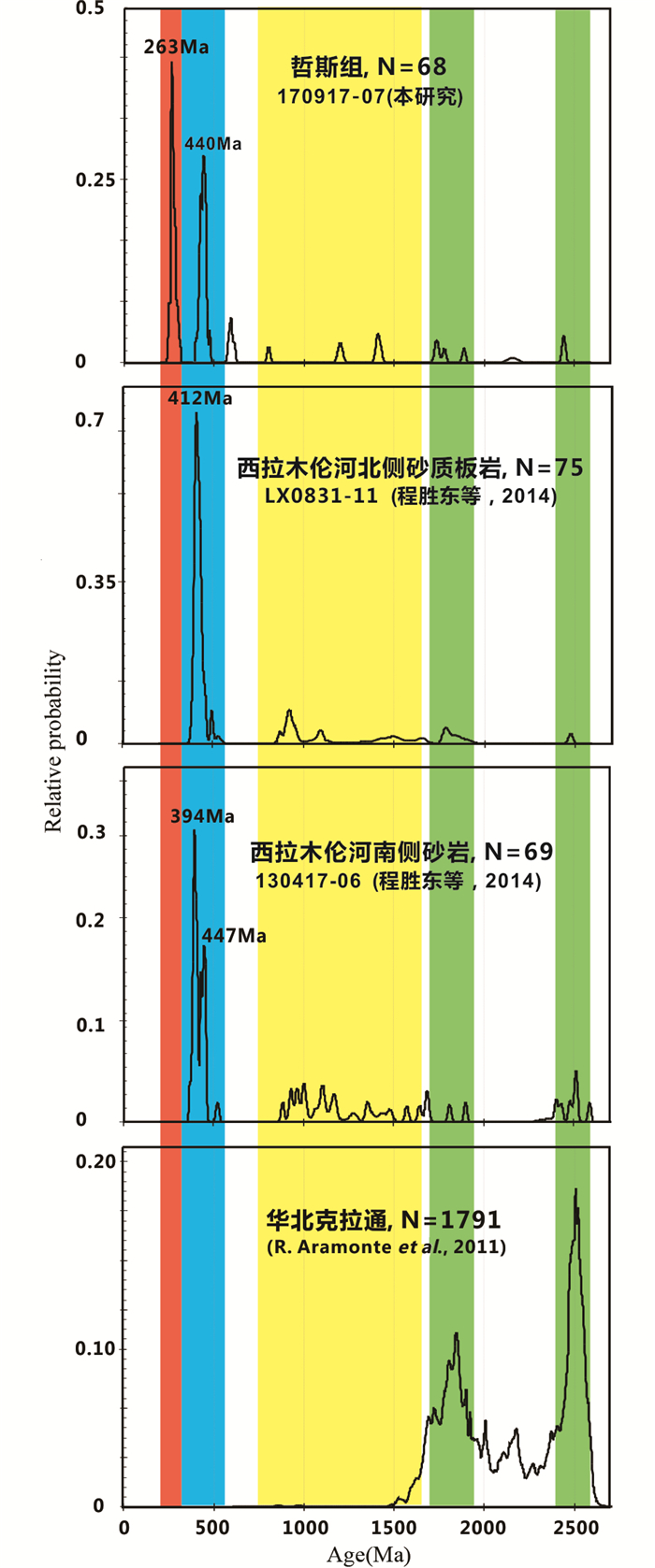
|
图 11 哲斯组与潜在物源区碎屑锆石年龄谱对比图 Fig. 11 Comparison of detrital zircon age spectrums from Zhesi Formation and potential provenance terranes |
另一方面,本研究确定的三角洲沉积组合揭示近源快速堆积快速沉降的沉积环境,结合近年来发现的同时期岩浆活动,例如246~260Ma的基性岩(Miao et al., 2007)、263~246Ma双峰式火山岩(王子进等,2013)以及二叠纪碱性岩带等(徐备等,2014),其地球化学特征均代表造山后伸展环境,表明晚二叠世处于区域伸展构造背景,这也为发育裂谷盆地提供了形成条件。
5 结论(1) 研究区哲斯组凝灰质砂岩和安山岩样品中最年轻锆石组的年龄为262±1Ma和258±17Ma,表明其形成时代为中-晚二叠世。哲斯组的沉积环境为三角洲前缘相与前三角洲相的多次交替,沉积过程受到火山活动的影响。
(2) 哲斯组碎屑锆石年代分析和古流向恢复表明,其主要物源为同期火山活动以及研究区以南的华北克拉通及其北缘早古生代陆缘弧,也有部分物源可能来自于温都尔庙群。来自南部的大量物源说明中二叠世时研究区已与华北板块连通,并没有类似大洋俯冲带的阻隔作用。
(3) 研究区中二叠世古地理格局并不具备深海远源浊积扇的发育条件,而是处于近源快速堆积的伸展环境。中二叠世既不存在向南发育的广阔大陆边缘,也不存在代表板块边界的俯冲带。
致谢 北京大学造山带与地壳演化教育部重点实验室马芳高级工程师在锆石年龄测试方面给予了指导,匿名审稿人提出了很多宝贵的修改意见,在此表示衷心感谢!本文属于IGCP 662项目的系列出版物。
Andersen T and Griffin WL. 2004. Lu-Hf and U-Pb isotope systematics of zircons from the Storgangen intrusion, Rogaland Intrusive Complex, SW Norway:Implications for the composition and evolution of Precambrian lower crust in the Baltic Shield. Lithos, 73(3-4): 271-288. DOI:10.1016/j.lithos.2003.12.010 |
Chen B, Jahn BM and Tian W. 2009. Evolution of the Solonker suture zone:Constraints from zircon U-Pb ages, Hf isotopic ratios and whole-rock Nd-Sr isotope compositions of subduction-and collision-related magmas and forearc sediments. Journal of Asian Earth Sciences, 34(3): 245-257. DOI:10.1016/j.jseaes.2008.05.007 |
Chen JS, Liu M, Li B, LI W, Li WW, Yang F and Wang Y. 2017. Zircon U-Pb chronology and geochemical characteristics of Late Silurian monzogranite in Ongniud Bannar, Inner Mongolia. Geological Bulletin of China, 36(8): 1359-1368. |
Cheng SD, Fang JQ, Zhao P, Xu B, Bao QZ, Zhou YH and Deng RJ. 2014. Detrital zircon ages of the Silurian-Devonian clastic rocks in south and north banks of Xar Moron River, Inner Mongolia. Acta Petrologica Sinica, 30(7): 1909-1921. |
Cope T, Ritts BD, Darby BJ, Fildani A and Graham SA. 2005. Late Paleozoic sedimentation on the northern margin of the North China block:Implications for regional tectonics and climate change. International Geology Review, 47(3): 270-296. DOI:10.2747/0020-6814.47.3.270 |
Eizenhöfer PR, Zhao GC, Zhang J and Sun M. 2014. Final closure of the Paleo-Asian Ocean along the Solonker Suture Zone:Constraints from geochronological and geochemical data of Permian volcanic and sedimentary rocks. Tectonics, 33(4): 441-463. DOI:10.1002/2013TC003357 |
Eizenhöfer PR, Zhao GC, Sun M, Zhang J, Han YG and Hou WZ. 2015. Geochronological and Hf isotopic variability of detrital zircons in Paleozoic strata across the accretionary collision zone between the North China craton and Mongolian arcs and tectonic implications. GSA Bulletin, 127(9-10): 1422-1436. DOI:10.1130/B31175.1 |
Han GQ, Liu YJ, Wen QB, Li W, Wu LN, Zhao YL, Deng L, Zhao LM and Liang CY. 2011. LA-ICP-MS U-Pb dating of detrital zircons from the Permian sandstones in north side of Xar Moron river suture belt and its tectonic implications. Earth Science, 36(4): 687-702. |
Han J, Zhou JB, Zhang XZ and Qiu HJ. 2011. Detrital zircon U-Pb dating from sandstone of the Upper Permian Linxi Formation, Linxi area, Inner Mongolia, China and its tectonic implication. Geological Bulletin of China, 30(2-3): 258-269. |
Han J, Zhou JB, Wang B and Cao JL. 2015. The final collision of the CAOB:Constraint from the zircon U-Pb dating of the Linxi Formation, Inner Mongolia. Geoscience Frontiers, 6(2): 211-225. |
Jahn BM, Wu FY and Chen B. 2000. Granitoids of the Central Asian Orogenic Belt and continental growth in the Phanerozoic. Transactions of the Royal Society of Edinburgh Earth Sciences, 91(1-2): 181-193. DOI:10.1017/S0263593300007367 |
Jahn BM. 2004. The Central Asian Orogenic Belt and growth of the continental crust in the Phanerozoic. In:Fitton JG, Mahoney JJ, Wallace PJ and Saunders AD (eds.). Origin and Evolution of the Ontong Java Plateau. Geological Society, London, Special Publications, 226(1): 73-100. |
Jian P, Liu DY, Kröner A, Windley BF, Shi YR, Zhang FQ, Shi GH, Miao LC, Zhang W, Zhang Q, Zhang LQ and Ren JS. 2008. Time scale of an early to mid-Paleozoic orogenic cycle of the long-lived Central Asian Orogenic Belt, Inner Mongolia of China:Implications for continental growth. Lithos, 101(3-4): 233-259. DOI:10.1016/j.lithos.2007.07.005 |
Jian P, Liu DY, Kröner A, Windley BF, Shi YR, Zhang W, Zhang FQ, Miao LC, Zhang LQ and Tomurhuu D. 2010. Evolution of a Permian intraoceanic arc-trench system in the Solonker suture zone, Central Asian Orogenic Belt, China and Mongolia. Lithos, 118(1-2): 169-190. DOI:10.1016/j.lithos.2010.04.014 |
Khain EV, Bibikova EV, Kröner A, Zhuravlev DZ, Sklyarov EV, Fedotova AA and Kravchenko-Berezhnoy IR. 2002. The most ancient ophiolite of the Central Asian fold belt:U-Pb and Pb-Pb zircon ages for the Dunzhugur Complex, Eastern Sayan, Siberia, and geodynamic implications. Earth and Planetary Science Letters, 199(3-4): 311-325. DOI:10.1016/S0012-821X(02)00587-3 |
Kröner A, Windley BF, Badarch G, Tomurtogoo O, Hegner E, Jahn BM, Gruschka S, Khain EV, Demoux A and Wingate MTD. 2007. Accretionary growth and crust formation in the Central Asian Orogenic Belt and comparison with the Arabian-Nubian shield. In:Hatcher Jr RD, Carlson MP, McBride JH, Catalán JRM (eds.). 4-D Framework of Continental Crust. Geological Society of America Memoirs, 200: 181-209. |
Li HK, Su WB, Zhou HY, Xiang ZQ, Tian H, Yang LG, Huff WD and Ettensohn FR. 2014. The first precise age constraints on the Jixian System of the Meso-to Neoproterozoic Standard Section of China:SHRIMP zircon U-Pb dating of bentonites from the Wumishan and Tieling formations in the Jixian Section, North China Craton. Acta Petrologica Sinica, 30(10): 2999-3012. |
Li HY, Zhang D, Zhou ZG, Liu CF, Li PJ, Chen LZ and Gu CN. 2016. LA-ICP-MS U-Pb dating of detrital zircons from Linxi Formation and its geological implications in Hexigten Qi, Inner Mongolia. Journal of Jilin University (Earth Science Edition), 46(1): 146-162. |
Li JY. 2006. Permian geodynamic setting of Northeast China and adjacent regions:Closure of the Paleo-Asian Ocean and subduction of the Paleo-Pacific Plate. Journal of Asian Earth Sciences, 26(3-4): 207-224. DOI:10.1016/j.jseaes.2005.09.001 |
Li YL, Zhou HW, Brouwer FM, Xiao WJ, Wijbrans JR and Zhong ZQ. 2014. Early Paleozoic to Middle Triassic bivergent accretion in the Central Asian Orogenic Belt:insights from zircon U-Pb dating of ductile shear zones in central Inner Mongolia, China. Lithos, 205: 84-111. DOI:10.1016/j.lithos.2014.06.017 |
Liu DY, Jian P, Zhang Q, Zhang FQ, Shi YR, Shi GH, Zhang NQ and Tao H. 2003. SHRIMP dating of adakites in the Tulingkai ophiolite, Inner Mongolia:Evidence for the Early Paleozoic subduction. Acta Geologica Sinica, 77(3): 317-327. |
Liu JF, Li JY, Chi XG, Feng QW, Hu ZC and Zhou K. 2013. Early Devonian felsic volcanic rocks related to the arc-continent collision on the northern margin of North China craton:Evidences of zircon U-Pb dating and geochemical characteristics. Geological Bulletin of China, 32(2-3): 267-278. |
Ludwig KR. 2003. Isoplot, Rev. 3.75. A geochronological toolkit for Microsoft Excel. Berkeley Geochronology Center Special Publication, No.5: 1-75
|
Miao LC, Liu DY, Zhang FQ, Fan WM, Shi YR and Xie HQ. 2007. Zircon SHRIMP U-Pb ages of the "Xinghuadukou Group" in Hanjiayuanzi and Xinlin areas and the "Zhalantun Group" in Inner Mongolia, Da Hinggan Mountains. Chinese Science Bulletin, 52(8): 1112-1134. DOI:10.1007/s11434-007-0131-2 |
Pei FP, Wang ZW, Cao HH, Xu WL and Wang F. 2014. Petrogenesis of the Early Paleozoic tonalite in the central Jilin Province:Evidence from zircon U-Pb chronology and geochemistry. Acta Petrologica Sinica, 30(7): 2009-2019. |
Qin Y, Liang YM, Yan JL, Zhang QW and Liu CX. 2013. The identification of Early Paleozoic O-type adakitic rocks in Zhengxiangbaiqi area, Inner Mongolia and its significance. Earth Science Frontiers, 20(5): 106-114. |
Rojas-Agramonte Y, Kröner A, Demoux A, Xia X, Wang W, Donskaya T, Liu D and Sun M. 2011. Detrital and xenocrystic zircon ages from Neoproterozoic to Palaeozoic arc terranes of Mongolia:Significance for the origin of crustal fragments in the Central Asian Orogenic Belt. Gondwana Research, 19(3): 751-763. DOI:10.1016/j.gr.2010.10.004 |
Rubatto D and Hermann J. 2003. Zircon formation during fluid circulation in eclogites (Monviso, Western Alps):Implications for Zr and Hf budget in subduction zones. Geochimica et Cosmochimica Acta, 67(12): 2173-2187. DOI:10.1016/S0016-7037(02)01321-2 |
Şengör AMC, Natal'in BA, Burtman VS. 1993. Evolution of the Altaid tectonic collage and Palaeozoic crustal growth in Eurasia. Nature, 364(6435): 299-307. |
Shanmugam G. 1997. The Bouma Sequence and the turbidite mind set. Earth Science Reviews, 42(4): 201-229. DOI:10.1016/S0012-8252(97)81858-2 |
Shao JA, Tang KD and He GQ. 2014. Early Permian tectono-palaeogeographic reconstruction of Inner Mongolia, China. Acta Petrologica Sinica, 30(7): 1858-1866. |
Sláma J, Kostler J, Condon DJ, Crowley JL, Gerdes A, Hanchar JM, Horstwood MSA, Morris GA, Nasdala B and Turbett MN. 2008. Plešovice:A new natural reference material for U-Pb and Hf isotopic analysis. Chemical Geology, 197: 111-142. |
Song B, Zhang YH, Wan YS and Jian P. 2002. Mount making and procedure of the SHRIMP dating. Geological Review, 48(Suppl.): 26-30. |
Su WB, Li HK, Huff WD, Ettensohn FR, Zhang SH, Zhou HY and Wan YS. 2010. SHRIMP U-Pb dating for a K-bentonite bed in the Tieling Formation, North China. Chinese Science Bulletin, 55(29): 3312-3323. DOI:10.1007/s11434-010-4007-5 |
Sun LP. 2005. The research on Mesozonic tectono-sedimentary relationship between Dabie Orogen and Heifei basin. Ph. D. Dissertation. Shanghai: Tongji University.
|
Wang DD, Li SZ, Zhou XG, Liu WW, Lin YH, Zeng QN and Zhang WH. 2016. SHRIMP U-Pb dating of detrital zircon from the Upper Permian Linxi Formation in eastern Inner Mongolia, and its geological significance. Geological Review, 62(4): 1021-1040. |
Wang YY, Xu B, Cheng SD, Liao W, Shao J and Wang Y. 2014. Zircon U-Pb dating of the mafic lava from Wudaoshimen, Hexigten, Inner Mongolia and its geological significance. Acta Petrologica Sinica, 30(7): 2055-2062. |
Wang ZJ, Xu WL, Pei FP and Cao HH. 2013. Middle Permian-Early Triassic mafic magmatism and its tectonic implication in the eastern section of the southern margin of the Xing'an-Mongolian Orogenic Belt, NE China:Constraints from zircon U-Pb geochronology and geochemistry. Geological Bulletin of China, 32(2-3): 374-387. |
Wiedenbeck M, Allé P, Corfu F, Griffin WL, Meier M, Oberli F, von Quadt A, Roddick JC and Spiegel W. 1995. Three natural zircon standards for U-Th-Pb, Lu-Hf, trace element and REE analyses. Geostandards and Geoanalytical Research, 19(1): 1-23. DOI:10.1111/ggr.1995.19.issue-1 |
Xiao WJ, Windley BF, Hao J and Zhai MG. 2003. Accretion leading to collision and the Permian Solonker suture, Inner Mongolia, China:Termination of the Central Asian Orogenic Belt. Tectonics, 22(6): 1069. DOI:10.1029/2002TC001484 |
Xu B, Charvet J, Chen Y, Zhao P and Shi GZ. 2013. Middle Paleozoic convergent orogenic belts in western Inner Mongolia (China):Framework, kinematics, geochronology and implications for tectonic evolution of the Central Asian Orogenic Belt. Gondwana Research, 23(4): 1324-1364. |
Xu B, Zhao P, Bao QZ, Zhou YH, Wang YY and Luo ZW. 2014. Preliminary study on the pre-Mesozoic tectonic unit division of the Xing-Meng Orogenic Belt (XMOB). Acta Petrologica Sinica, 30(7): 1841-1857. |
Xu B, Xu Y, Li J and Li QS. 2016. Age of the Ondor Sum Group in western Inner Mongolia and its position in the Central Asia Orogenic Belt. Earth Science Frontiers, 23(6): 120-127. |
Yang B, Zhang XH, Yang XJ and Xia HD. 2017. Brachiopod Faunas from the Permian Jisu Honguer (Zhesi) Formation in Xilinhot, Inner Mongolia, and its significance. Geological Bulletin of China, 36(10): 1683-1690. |
Zhang W and Jian P. 2008. SHRIMP dating of Early Paleozoic granites from North Damaoqi, Inner Mongolia. Acta Geologica Sinica, 82(6): 778-787. |
Zhang W, Jian P, Kröner A and Shi YR. 2013. Magmatic and metamorphic development of an early to mid-Paleozoic continental margin arc in the southernmost Central Asian Orogenic Belt, Inner Mongolia, China. Journal of Asian Earth Sciences, 72: 63-74. DOI:10.1016/j.jseaes.2012.05.025 |
Zhang YP and Tang KD. 1989. Pre-Jurassic tectonic evolution of intercontinental region and the suture zone between the North China and Siberian platforms. Journal of Southeast Asian Earth Sciences, 3(1-4): 47-55. DOI:10.1016/0743-9547(89)90008-1 |
Zhao P, Chen Y, Xu B, Faure M, Shi GZ and Choulet F. 2013. Did the Paleo-Asian Ocean between North China Block and Mongolia Block exist during the Late Paleozoic? First paleomagnetic evidence from central-eastern Inner Mongolia, China. Journal of Geophysical Research:Solid Earth, 118(5): 1873-1894. DOI:10.1002/jgrb.50198 |
Zhao YL, Li WM, Wen QB, Liang CY, Feng ZQ, Hou JP and Shen L. 2016. Late Paleozoic tectonic framework of eastern Inner Mongolia:Evidence from the detrital zircon U-Pb ages of the Mid-late Permian to Early Triassic sandstones. Acta Petrologica Sinica, 32(9): 2807-2822. |
Zhu JB and He ZJ. 2017. Detrital zircon records of Upper Permian-Middle Triassic sedimentary sequence in the Linxi area, Inner Mongolia and constraints on timing of final closure of the Paleo-Asian Ocean (eastern segment). Acta Geologica Sinica, 91(1): 232-248. DOI:10.1111/1755-6724.13074 |
陈井胜, 刘淼, 李斌, 李伟, 李崴崴, 杨帆, 汪岩. 2017. 内蒙古翁牛特旗晚志留世二长花岗岩年代学及地球化学特征. 地质通报, 36(8): 1359-1368. DOI:10.3969/j.issn.1671-2552.2017.08.006 |
程胜东, 方俊钦, 赵盼, 徐备, 鲍庆中, 周永恒, 邓荣敬. 2014. 内蒙古西拉木伦河两岸志留-泥盆系碎屑锆石年龄及其构造意义. 岩石学报, 30(7): 1909-1921. |
韩国卿, 刘永江, 温泉波, 李伟, 吴琳娜, 赵英利, 丁凌, 赵立敏, 梁琛岳. 2011. 西拉木伦河缝合带北侧二叠纪砂岩碎屑锆石LA-ICP-MS U-Pb年代学及其构造意义. 地球科学, 36(4): 687-702. |
韩杰, 周建波, 张兴洲, 邱海峻. 2011. 内蒙古林西地区上二叠统林西组砂岩碎屑锆石的年龄及其大地构造意义. 地质通报, 30(2-3): 258-269. |
李怀坤, 苏文博, 周红英, 相振群, 田辉, 杨立公, Huff WD, Ettensohn FR. 2014. 中-新元古界标准剖面蓟县系首获高精度年龄制约——蓟县剖面雾迷山组和铁岭组斑脱岩锆石SHRIMP U-Pb同位素定年研究. 岩石学报, 30(10): 2999-3012. |
李红英, 张达, 周志广, 柳长峰, 李鹏举, 陈利贞, 谷丛楠. 2016. 内蒙古克什克腾旗林西组碎屑锆石LA-ICP-MS年代学及其地质意义. 吉林大学学报(地球科学版), 46(1): 146-162. |
刘敦一, 简平, 张旗, 张福勤, 石玉若, 施光海, 张履桥, 陶华. 2003. 内蒙古图林凯蛇绿岩中埃达克岩SHRIMP测年:早古生代洋壳消减的证据. 地质学报, 77(3): 317-327. DOI:10.3321/j.issn:0001-5717.2003.03.004 |
刘建峰, 李锦轶, 迟效国, 冯乾文, 胡兆初, 周坤. 2013. 华北克拉通北缘与弧-陆碰撞相关的早泥盆世长英质火山岩——锆石U-Pb定年及地球化学证据. 地质通报, 32(2-3): 267-278. |
裴福萍, 王志伟, 曹花花, 许文良, 王枫. 2014. 吉林省中部地区早古生代英云闪长岩的成因:锆石U-Pb年代学和地球化学证据. 岩石学报, 30(7): 2009-2019. |
秦亚, 梁一鸿, 邢济麟, 张青伟, 刘城先. 2013. 内蒙古正镶白旗地区早古生代O型埃达克岩的厘定及其意义. 地学前缘, 20(5): 106-114. |
邵济安, 唐克东, 何国琦. 2014. 内蒙古早二叠世构造古地理的再造. 岩石学报, 30(7): 1858-1866. |
宋彪, 张玉海, 万渝生, 简平. 2002. 锆石SHRIMP样品靶制作、年龄测定及有关现象讨论. 地质论评, 48(增): 26-30. |
苏文博, 李怀坤, Huff WD, Ettensohn FR, 张世红, 周红英, 万渝生. 2010. 铁岭组钾质斑脱岩锆石SHRIMP U-Pb年代学研究及其地质意义. 科学通报, 55(22): 2197-2206. |
孙连浦. 2005. 大别造山带与合肥盆地中生代构造-沉积演化关系研究.博士学位论文. 上海: 同济大学.
|
王丹丹, 李世臻, 周新桂, 刘伟伟, 林燕华, 曾秋楠, 张文浩. 2016. 内蒙古东部上二叠统林西组砂岩锆石SHRIMP U-Pb年代学及其构造意义. 地质论评, 62(4): 1021-1040. |
王炎阳, 徐备, 程胜东, 廖闻, 邵军, 汪岩. 2014. 内蒙古克什克腾旗五道石门基性火山岩锆石U-Pb年龄及其地质意义. 岩石学报, 30(7): 2055-2062. |
王子进, 许文良, 裴福萍, 曹花花. 2013. 兴蒙造山带南缘东段中二叠世末-早三叠世镁铁质岩浆作用及其构造意义——来自锆石U-Pb年龄与地球化学的证据. 地质通报, 32(2-3): 374-387. |
徐备, 赵盼, 鲍庆中, 周永恒, 王炎阳, 罗志文. 2014. 兴蒙造山带前中生代构造单元划分初探. 岩石学报, 30(7): 1841-1857. |
徐备, 徐严, 栗进, 李群生. 2016. 内蒙古西部温都尔庙群的时代及其在中亚造山带中的位置. 地学前缘, 23(6): 120-127. |
杨兵, 张雄华, 杨欣杰, 夏浩东. 2017. 内蒙古锡林浩特二叠系哲斯组腕足动物群特征及其意义. 地质通报, 36(10): 1683-1690. DOI:10.3969/j.issn.1671-2552.2017.10.001 |
张维, 简平. 2008. 内蒙古达茂旗北部早古生代花岗岩类SHRIMP U-Pb年代学. 地质学报, 82(6): 778-787. DOI:10.3321/j.issn:0001-5717.2008.06.007 |
赵英利, 李伟民, 温泉波, 梁琛岳, 冯志强, 周建平, 申亮. 2016. 内蒙东部晚古生代构造格局:来自中、晚二叠-早三叠世砂岩碎屑锆石U-Pb年代学的证据. 岩石学报, 32(9): 2807-2822. |
朱俊宾, 和政军. 2017. 内蒙古林西地区上二叠统-中三叠统沉积序列的碎屑锆石记录及对古亚洲洋(东段)闭合时间的制约. 地质学报, 91(1): 232-248. |
 2018, Vol. 34
2018, Vol. 34


